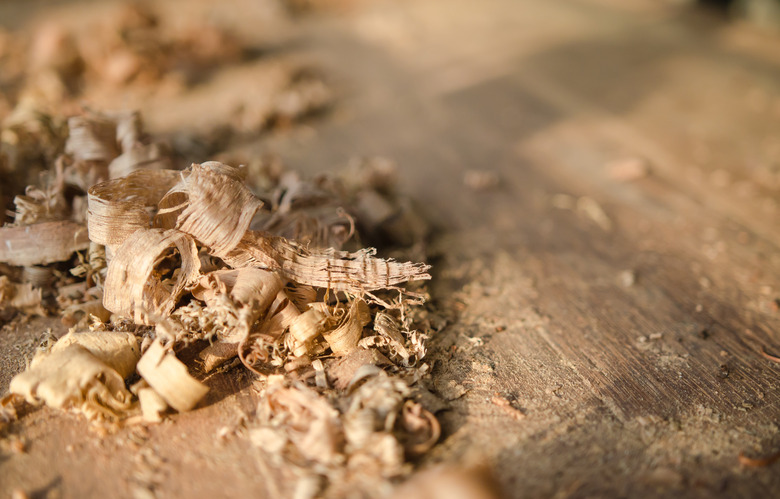How To Separate Salt, Sawdust & Iron When They Are Mixed Together
Separating salt, sawdust and iron when they are mixed together is a classic science challenge that requires separating diverse materials. While the challenge may seem daunting at first, careful consideration of the materials suggests ideas for attacking the problem. In particular, the differences between the materials provide clues and, ultimately, a solution.
TL;DR (Too Long; Didn't Read)
To separate salt, sawdust and iron, use a magnet to separate the iron. Then, add water to dissolve the salt and float the sawdust. Skim off, sieve or filter the solution to separate the sawdust. Let the water evaporate, leaving the salt behind.
Define the Materials
Define the Materials
Consider the properties of each material. Iron has a high density of 7.87 grams per cubic centimeter and is magnetic. With rare exceptions, wood has low density, lower than the density of water, which means the sawdust most likely will float in water. Also, wood burns. Salt has an intermediate density of 2.17 grams per cubic centimeter and dissolves in water. The sawdust particles may or may not be larger than the salt crystals. The iron, however, may be a powder or may be larger pellets. Knowing the particle size might offer another possible solution.
Evaluate Possible Solutions
Evaluate Possible Solutions
If the three materials differ enough in size, they can be separated using sieves or screens with different size openings. Without information about particle size, however, this solution becomes uncertain.
Density could also be used to separate the three materials. Shaking the materials would eventually cause layering, with the iron settling at the bottom of the container, salt forming the middle layer, and sawdust rising to form the top layer. If the salt particles are significantly smaller than the iron particles, however, the salt might fill spaces between the iron particles, at least in the upper iron layers.
Using the special properties of each material also suggests solutions. If separation is the goal, without concern for the condition of the materials, then the sawdust could be burned away, leaving the salt and iron, which allows the salt to be dissolved in water, leaving the iron. Alternately, the iron could be removed using a magnet, then water added to the wood and salt mixture. The salt dissolves, and the wood floats, leaving any remaining iron to sink. If the challenge requires capturing all three materials, however, burning the wood must be eliminated as a solution.
Select the Practical Solution
Select the Practical Solution
Based on the presumption that all three materials must be reclaimed without damage, using the special properties seems most practical. Therefore, using density differences, water and a magnet seems the most efficient solution.
How to Separate Salt, Sawdust and Iron
1. Separate the Iron
If the materials must be reclaimed and undamaged, start by using a magnet to capture and isolate the iron. Spread the mixture in a pan and draw the magnet through the material, capturing and separating the iron from the salt and sawdust. Repeat until the magnet doesn't capture any more iron. If the iron is too hard to remove from the magnet, drag the magnet across the bottom of the container, moving the iron to one side without directly touching the iron with the magnet.
2. Cover the Mixture With Water
Place the remaining mixture in a container large enough to hold the materials and with room to add water. Add water to cover the mixture, then stir gently. Be sure to stir all the way to the bottom of the container. As stirring continues, any remaining iron will settle to the bottom of the container. The salt will dissolve in the water, and the sawdust will float.
3. Skim the Sawdust
Carefully skim off the sawdust and set it aside to dry. Alternately, use a sieve or filter paper to capture the sawdust.
4. Evaporate the Water
Pour the water into a shallow pan. Let the water evaporate naturally or heat gently to accelerate the evaporation process. The salt is left behind.
Note: If any iron remains in the jar, be sure the iron dries completely before adding it to the previously separated iron. Any remaining water might cause the iron to rust.
Looking Beyond the Challenge
Looking Beyond the Challenge
For those who like to step beyond the challenge, the mass of the materials could be measured to check the methodology. Prior to separating the mixture, measure the mass of the total mixture. After separating and drying all the materials, measure the mass of each material. Add the three masses together. The total should equal the initial mass if all materials were recaptured during the separation process.
Cite This Article
MLA
Blaettler, Karen G. "How To Separate Salt, Sawdust & Iron When They Are Mixed Together" sciencing.com, https://www.sciencing.com/separate-salt-sawdust-iron-mixed-together-5986/. 7 May 2018.
APA
Blaettler, Karen G. (2018, May 7). How To Separate Salt, Sawdust & Iron When They Are Mixed Together. sciencing.com. Retrieved from https://www.sciencing.com/separate-salt-sawdust-iron-mixed-together-5986/
Chicago
Blaettler, Karen G. How To Separate Salt, Sawdust & Iron When They Are Mixed Together last modified March 24, 2022. https://www.sciencing.com/separate-salt-sawdust-iron-mixed-together-5986/
